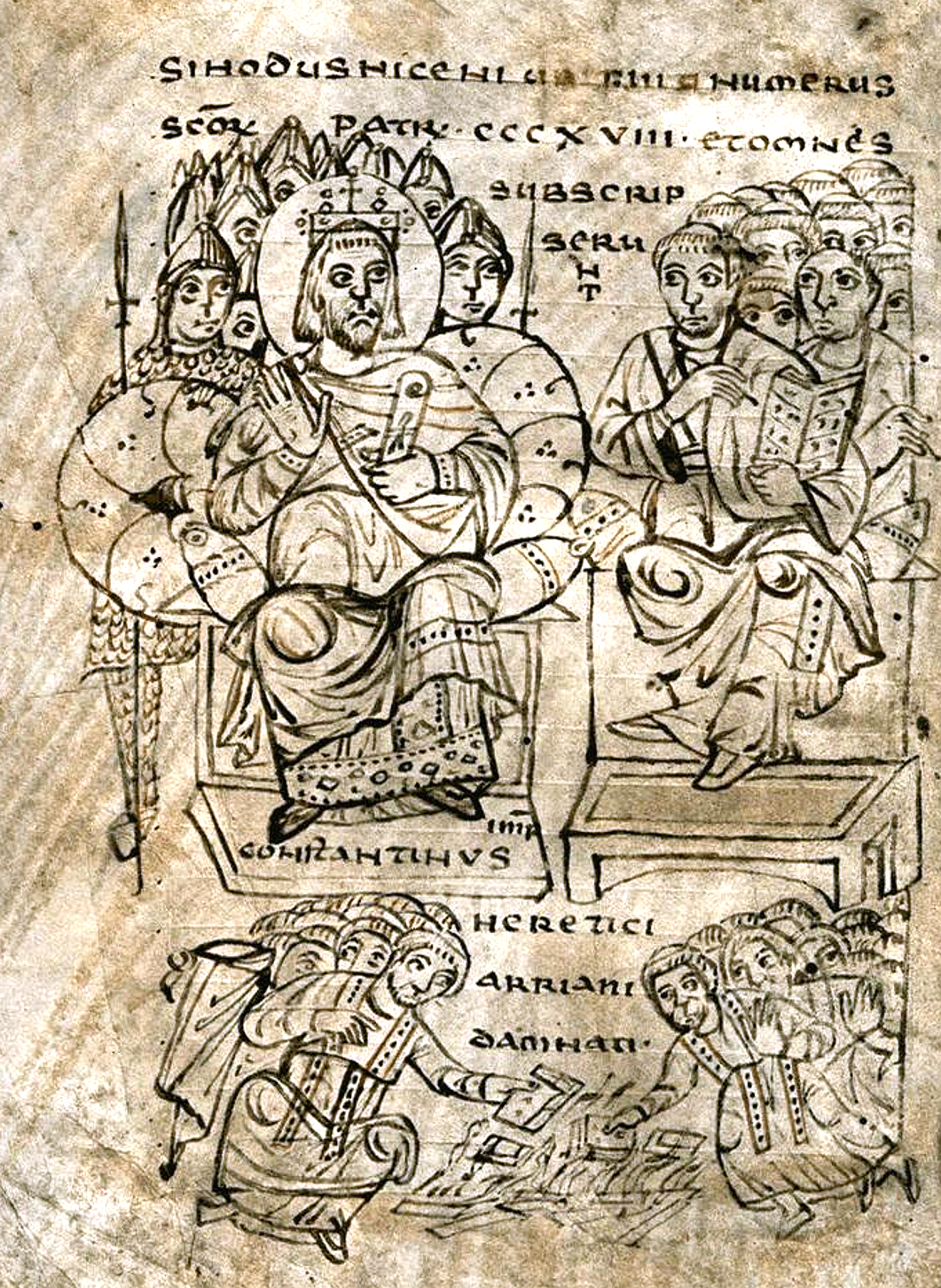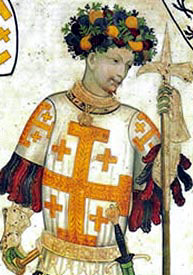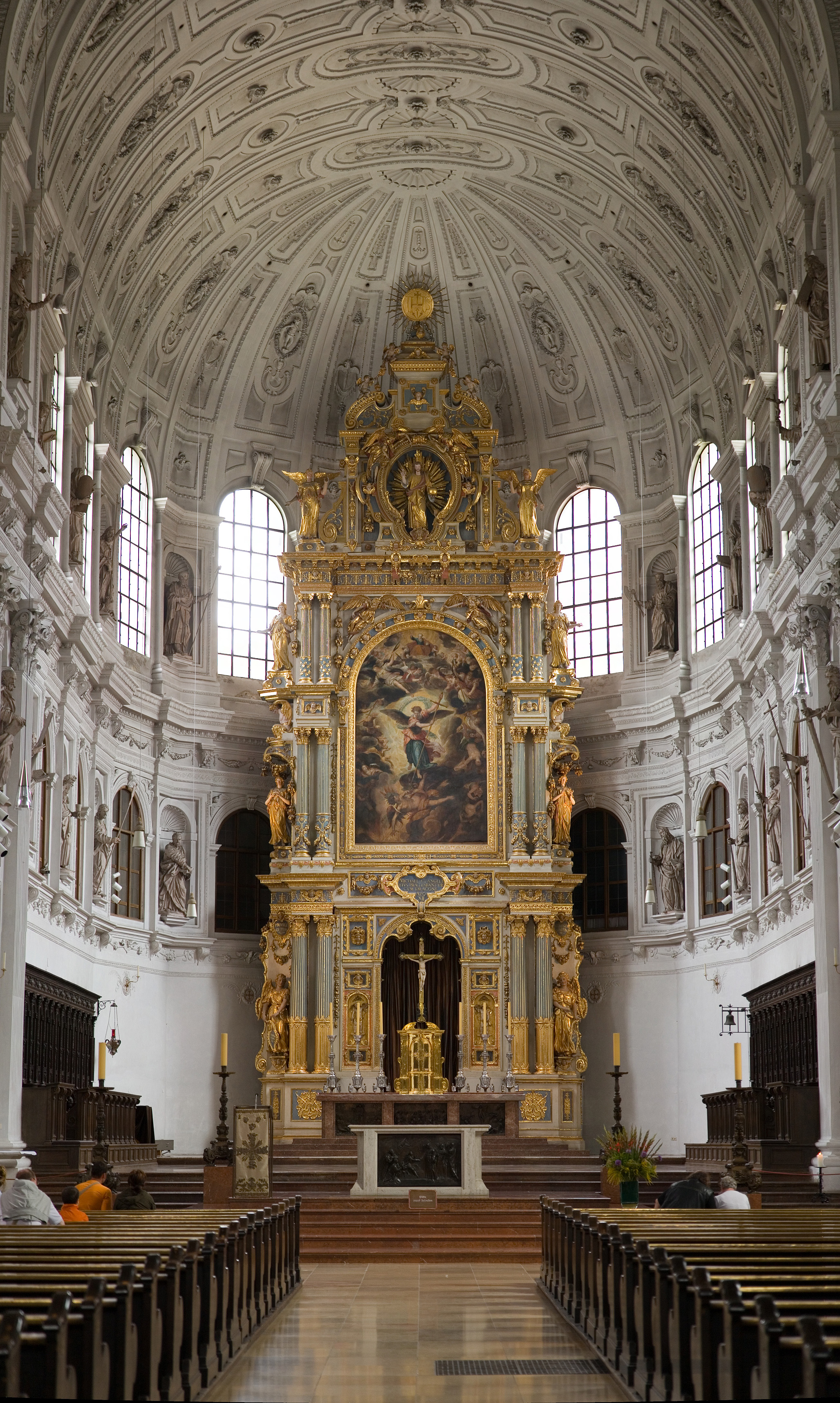Translation
by Ingrid Skibbe
Apostasy
and Restoration
What
did the Roman Emperor Constantine (275-337) do to the teachings of Jesus
Christ?
| Head of Constantine's colossal statue at the Capitoline Museums |
From Wikipedia, the free encyclopedia:
"The reign of Constantine established a precedent for the position of the emperor as having great influence and ultimate regulatory authority within the religious discussions involving the early Christian councils of that time, e.g., most notably the dispute over Arianism, and the nature of God... Arius asserted that the Son of God was a subordinate entity to God the Father. Deemed a heretic by the Ecumenical First Council of Nicaea of 325 "
 |
| Constantine burning Arian books |
Question: Would a Christian of the first three Centuries be more familiar with
the main stream (established ) Christian beliefs or with Mormonism?
"Mormonism",
perhaps the most tolerant Religion worldwide, by many could experts
defined as a mere mix of American Ideologies, stands in stark
opposition to the catholic influences of religious teachings.
Dr.
Rüdiger Hauth well known Protestant German Critic of Mormonism states:
“Mormonism is a distinct
syncretic American New Religion. A change to Mormonism would
necessitate a total change of beliefs, a turning away from all
biblical traditions and ecumenical Christian Communities.
Mormonism represents a
totally foreign (alien) World.” (1)
However as we are blessed to live in a time where information has become our elixir of life and democracy. Inasmuch as we all claim to be Christians. Endowed with the ability to reason. I feel at liberty to take a closer look at Dr. Hauths statements. I feel obliged to present some of the results gained through a lifetime of studying historic events. Especially as his totally opposing views appear in many publications freely given to an unsuspecting Public.
Again
I ask the poignant Question: Would a Christian of the first three
Centuries placed in today’s World feel at ease if he, let us say:
were placed at an evangelical Church congress?
 |
| Jerusalem Cross logo of the German Protestant Church Congress |
 |
| Godfrey of Bouillon as depicted in a late medieval fresco (Castello della Manta, Piedmont, Italy, c. 1420.) |
From Wikipedia, the free encyclopedia:
In the early 20th century, the Jerusalem cross also came to be used as a symbol of world evangelisation in Protestantism.
The design originates with the coat of arms worn by Godfrey of Bouillon during the First Crusade, and it remained in use as the armorial of the Kingdom of Jerusalem throughout its duration (1099–1291).[1] The symbolism of the five-fold cross is variously given as the Five Wounds of Christ, Christ and the four quarters of the world, Christ and the four evangelists. The "false blazonry" used for the Kingdom of Jerusalem ("metal upon metal", i.e. or (gold) on argent (silver)) was connected to Psalms 68:13, which mentions a "dove covered in silver, and her feathers with yellow gold".[1] The symbolism of five crosses representing the Five Wounds is first recorded earlier in the 11th century, with the consecration of the St Brelade's Church under the patronage of Robert of Normandy (before 1035); the crosses are incised in the church's altar slab.
If he - a Christian of the first three
Centuries - were left to
exam all the proceedings of such a day. Would he find all that is
familiar or would he find himself lost in a different and totally
alien environment?
| Seville Cathedral, the third largest church building in the world. On the top: Constanine Banner (2) |
If
our visitor from the past were left in one of the huge Cathedrals or
Dom’s. Would he feel at home? Or would the dimensions and coldness
there of alarm him?
In
the 21 century we aware of the fact that these enormous Buildings
were just another expression of Constantine gigantism and pride,
having nothing at all to do with our early Christian reality.
Excavations have proven that prior to the year of 320 there were in
Rome no Chapels or Basilicas, there were nowhere altars! (3)
Our
visitor from the past would be very surprised.
On
the 7th of November 2005 under the Title “Discovery of
the oldest Christian church” was reported in the “Spiegel”:
"Archaeologists had excavated
what they believe to be the oldest Christian Church in Megiddo,
Israel beneath the ruins of an old Prison. They found writings of
Greek origin, geometric works of art, The name of Christ in a circle
of fishes. Which we know to be the early symbol of Christianity.
The excavations substantiate
that instead of an Altar, - like we find them in 20 centuries Churches,
- they found only a hint of a “Table” in the centre of the room.
Leah di Segni expert at the Hebrew University in Jerusalem
explained, (quote): The Idea of the definition of “Table” instead
of “Altar” could have a dramatic result in regards to the study
of early rituals, because the expected belief of our day is, that
Jesus Christ administered the Sacrament on an Altar.” (4)
 |
| High altar of St. Michael's Church, Munich |
In
utter amazement our Brother from the past would ask: People get paid
for working in the Church?
"Church ... tends ... to defend once acquired property and acquired positions.'s Ability to self-restraint and self-circumcision is not developed in the right way."
(Joseph Cardinal Ratzinger in the book "Salt of the Earth", Stuttgart, 1996, p 185)
(Joseph Cardinal Ratzinger in the book "Salt of the Earth", Stuttgart, 1996, p 185)
In
the Year 220 a Roman Bishop by the name of Hippolyt laments the fact
that the members of the Theodotian Congregation pay a monthly wage to
their Bishop. He calls it an “outrageous new Idea” (5)
| Roman sculpture, maybe of Hippolytus, found in 1551 |
In
utter bewilderment our visitor would gaze to behold the Clerical and
ecclesiastical Robes and Head coverings of today’s Pastors and
Bishops. The Leaders of his time never wore any kind of
different attire as the remainder of the congregation.
 |
| Bishopric Wien 5 from left Victor Wadosch, Bishop Mayril, George Husz in their "uniforms" Nov. 2011 |
| The Indian Bishop Johnson Gnanabaranam Tamil Evangelical Lutheran Church in Tamil Nadu |
 |
| Bishopric Salzburg Andreas Dengg, Bischof Schubert, Elischa Grünauer, 2011 |
According
to Hertling (6)
“Not until the council
at Narbonne in the Year 589 did the wearing of ecclesiastical Robes
find their way into Church.”
With
great anguish our visitor would view the array of Crosses. Christians
of the first four centuries knew not the Cross as it represented the
Symbol of Christ’s death. For them, to carry the burden of the
cross implied:
To live as Lambs in a world of
Wolfs.
In
2010 The Bishops seat of Regensburg stated in the internet (7)
quote:
“The Symbol of the Cross
among Christians can only be found after the year of 375, at
the time of the great migrations of the Peoples.”
Crosses
where known as instruments of martyrdom, or as Symbols of Victory on
the flags of Roman legions. There they existed well over a hundred
years before the reign of Constantine.
In
the “Dialog to Octavius” written by Felix Minucius in the year of
200 he relates that the combination of the cross on which Jesus died
and the Crosses of the Romans in order to promote adoration and
worship are not desired. He writes to a non Christian citizen of Rome:
“We (Christians) will not
pray to a Cross and do not wish them. You however having consecrated
wooden Idols may choose to pray to wooden crosses as they are part
of your worship. Jet what more are they then the military emblems
on your Roman Banners and Flags. Your decorated and gilded Crosses,
Symbols of Victory. Do not only have the appearance of a simple
cross, they remind us of the Crucified.
With your (pagan)
customs comes the worshipping of the cross” (8)
The
man which at the council of Ephesus in 431 promoted the Cross of
Constantine to be a part of all Christian services was Cyril of
Alexandria.
I
dare not mention the kind of Church leader this man truly was,
perhaps you should endeavour to read an account written by Dr.
Leonhard Fendt. In his honest, brilliant, outspoken and totally
unafraid manner this valiant catholic Priest reports (9) how
this Cyril with the help of his uncle the Patriarch Theophilus of
Alexandria plundered the Temple of Serapes ( this was the Temple
dedicated to the biblical Joseph of Egypt). He (Dr. Fendt), does not
leave this power hungry “holy” Cyril with a single good hair on
his head.
In
the end – in 432 - much money had to be invested to release him
from Prison in which Emperor Theodosius II. had him transported
because of his quarrelsome behaviour in Constantinople.
Every
hair would stand on ends should our visitor be exposed to some of the
terrible fights between the “holy” Patriarch Cyril of Alexandria
and his religious opponent Nestorius.
In
the year of 431 these two did not only fight it out with words,
Pelusium a Friend of Cyril in a letter to Cyril wrote:
“Do not use so much
forceful language. Judge matters rightfully. Many of the members in
the council of Ephesus are mocking you because of you behaviour. It
seams as though you are at war with a personal enemy, not being
concerned about the affairs of the Church of Jesus Christ.” (10)
The
reason for so much contention between the Patriarchs at hand was if
Mary should be named after the manner of the Birth mother of Christ
(Christotokos) or whether she is to be called (Theotokos) the Birth
mother of God.
(Enjoy a look at the Book of Mormon 1.Nephi 11: 18, how easy it is)
(Enjoy a look at the Book of Mormon 1.Nephi 11: 18, how easy it is)
How
astonished people of our day would be on hearing the songs the Monks
at the Emperors Palace would sing as the news of the banishment of
Nestorius was made known.
“Despised are you, where
ever you may be, accursed are you before God. For Christ alone is
victorious at all times. Give the Jew to the Jews. Give the Traitor
to the Jews. The People cried :
“Take the traitor Nestorius
the Jew and burn him at the Stake.” He was exiled to the Egyptian
desert to perish. (11)
Question:
Answer:
We
would find a Society without Cathedrals, Dom’s no golden preacher
pulpit, a Church without paid Clergy. In a Christian church in which
every righteous male may hold the Priesthood, where all members are
equals, without Priestly attire. A Church without Altars, without
Infant baptism, no Belfries and no Crosses.
Happily
the only thing left would be the teachings of Jesus Christ. And even
He would be a different kind of Christ, a Christ in which his
teachings once more would illuminate the World.
Would
we send our Visitor from the past into a Chapel of the Church of
Jesus Christ of Latter Day Saints? Any where worldwide, he would see
a Sacrament Table, an undecorated Room. No Crosses, no Pictures, a
Speakers pulpit. He would find a Bishop and two Bishop Counsellors
caring for the Spiritual as well as some of the physical needs of his
Congregation just as it used to be.
He would find gatherings of men holding the holy Priesthood, as well as that of the Women, Young Adults and Children. All enjoying equal rights. Being instructed by dedicated unpaid teachers.
| Chapel of the Church of Jesus Christ of Latter-Day Saints Austria , Vienna |
He would find gatherings of men holding the holy Priesthood, as well as that of the Women, Young Adults and Children. All enjoying equal rights. Being instructed by dedicated unpaid teachers.

Even
the topics would be a reflection of those in the early gatherings of
the Saints. Only in extreme situations would Politics find their way
inside the walls of a Chapel. For now as then the focus should be on
Joy. “Men are that they may have Joy" for thus teaches the Book
of Mormon. The main concern of all Latter Day Leaders, our Prophet,
the 12 apostles, the Seventies, Stake Presidents and Bishops now and
then are the temporal and spiritual welfare of the Saints. For Jesus
taught:
 |
| "Mormon Church" sacrament meeting |
“Come unto me all ye who
are weary and heavy laden, and I will give you rest.”
Sources:
1.) “Dialog und Apologetik”, 2001
2.) The Giralda is the landmark of the City
Seville:
3.) K.-P. Hertzsch “Theologisches Lexikon, Union-Verlag, Berlin. 1977, S.13
4.) Spiegel vom 7. Nov. 2005
5.) Jungklaus, Full Text of “Die Gemeinde Hippolyts... nach seiner Kirchenordnung.
6.) Ludwig Hertling Imprimatur “Geschichte der katholischen Kirche bis 1740”, Morusverlag Berlin S. 46
7.) www.bistum-regensburg.de/borpage003359.asp
"Als allgemein verbreitetes und verwendetes Symbol der Christen lässt sich das Kreuzzeichen allerdings erst in der Zeit der Völkerwanderung (375 n. Chr. – 568n. Chr.) nachweisen. 423 n. Chr. findet sich z.B. eine Kreuzigungsdarstellung am Portal der Basilika Santa Sabina auf dem Aventin in Rom."
8.) Stemberger “2000 Jahre Christentum” Karl Müller Verlag, Erlangen, 1990, S.146
9.) Dr. Leonhardt Fendt “Die Christologie des Nestorius” katholisch theolog. Fakultät der Kaiser-Wilhelm Universität Straßburg, 1909 Kempten see Internet
10.) Christian Pesch “Nestorius als Irrlehrer” Paderborn, 1921, Verlag Schöningh
11.) Dr. L. Fendt Inaugural dissertation
... „Giraldillo
ist die den (christlichen) Glauben darstellende weibliche Figur mit
der Fahne Konstantins.“
Baedekers Reiseführer, Spanien, 5. Auflage, 1992. S. 584
Until 1402 stand here - Seville - the Moorish main mosque. Thus, The Giralda is also the symbol of the history of the royal word break and the expulsion of the Moors from Spain 800 000, as the elimination of the Jews.3.) K.-P. Hertzsch “Theologisches Lexikon, Union-Verlag, Berlin. 1977, S.13
4.) Spiegel vom 7. Nov. 2005
5.) Jungklaus, Full Text of “Die Gemeinde Hippolyts... nach seiner Kirchenordnung.
6.) Ludwig Hertling Imprimatur “Geschichte der katholischen Kirche bis 1740”, Morusverlag Berlin S. 46
7.) www.bistum-regensburg.de/borpage003359.asp
"Als allgemein verbreitetes und verwendetes Symbol der Christen lässt sich das Kreuzzeichen allerdings erst in der Zeit der Völkerwanderung (375 n. Chr. – 568n. Chr.) nachweisen. 423 n. Chr. findet sich z.B. eine Kreuzigungsdarstellung am Portal der Basilika Santa Sabina auf dem Aventin in Rom."
8.) Stemberger “2000 Jahre Christentum” Karl Müller Verlag, Erlangen, 1990, S.146
9.) Dr. Leonhardt Fendt “Die Christologie des Nestorius” katholisch theolog. Fakultät der Kaiser-Wilhelm Universität Straßburg, 1909 Kempten see Internet
10.) Christian Pesch “Nestorius als Irrlehrer” Paderborn, 1921, Verlag Schöningh
11.) Dr. L. Fendt Inaugural dissertation
Keine Kommentare:
Kommentar veröffentlichen